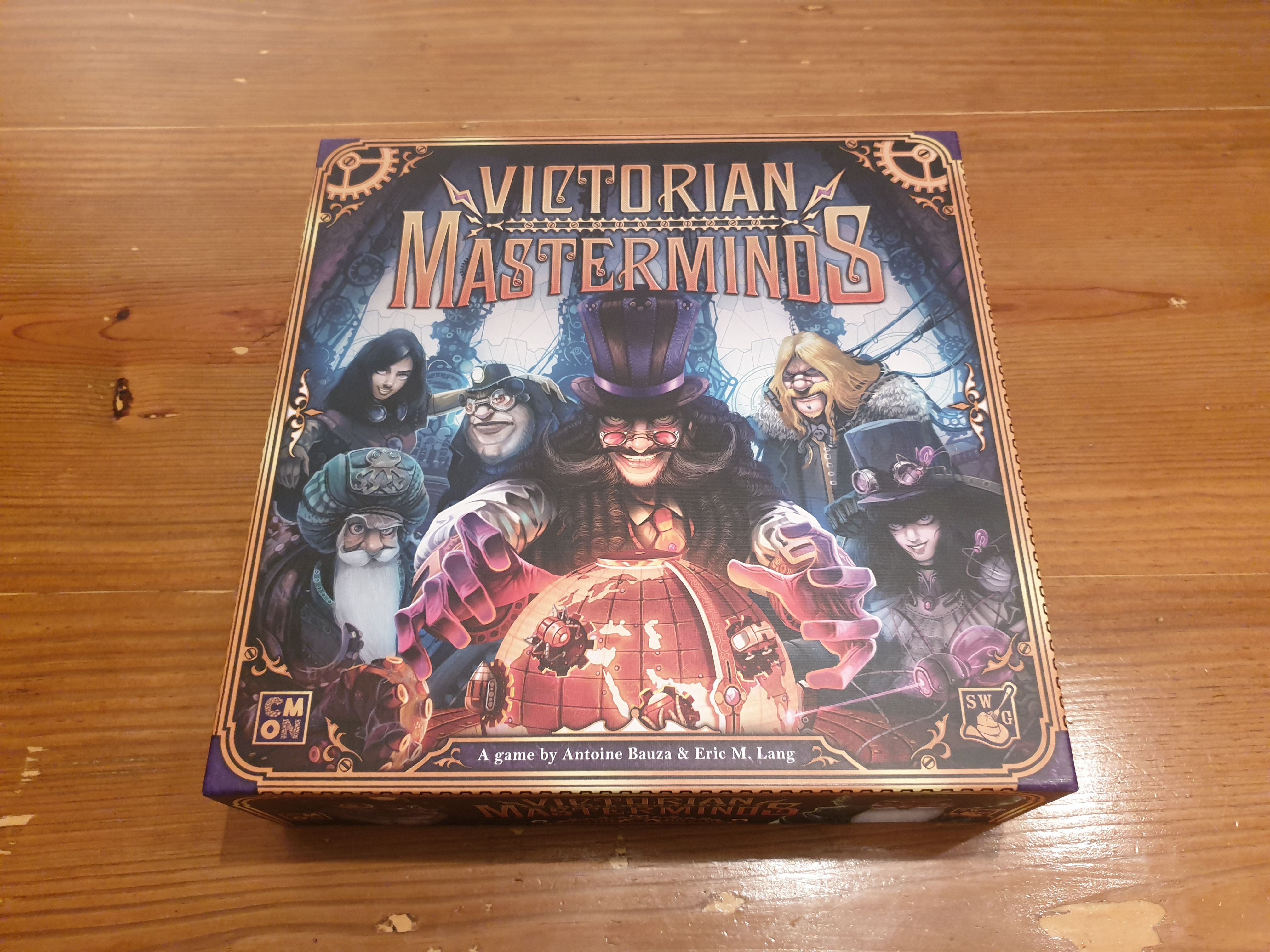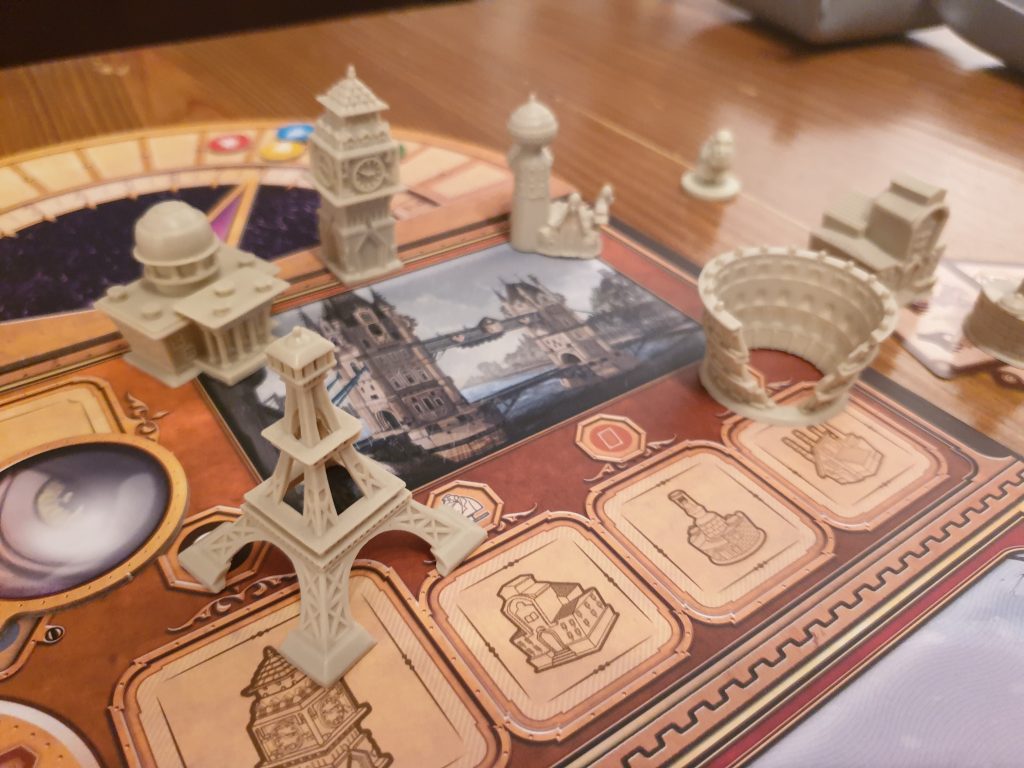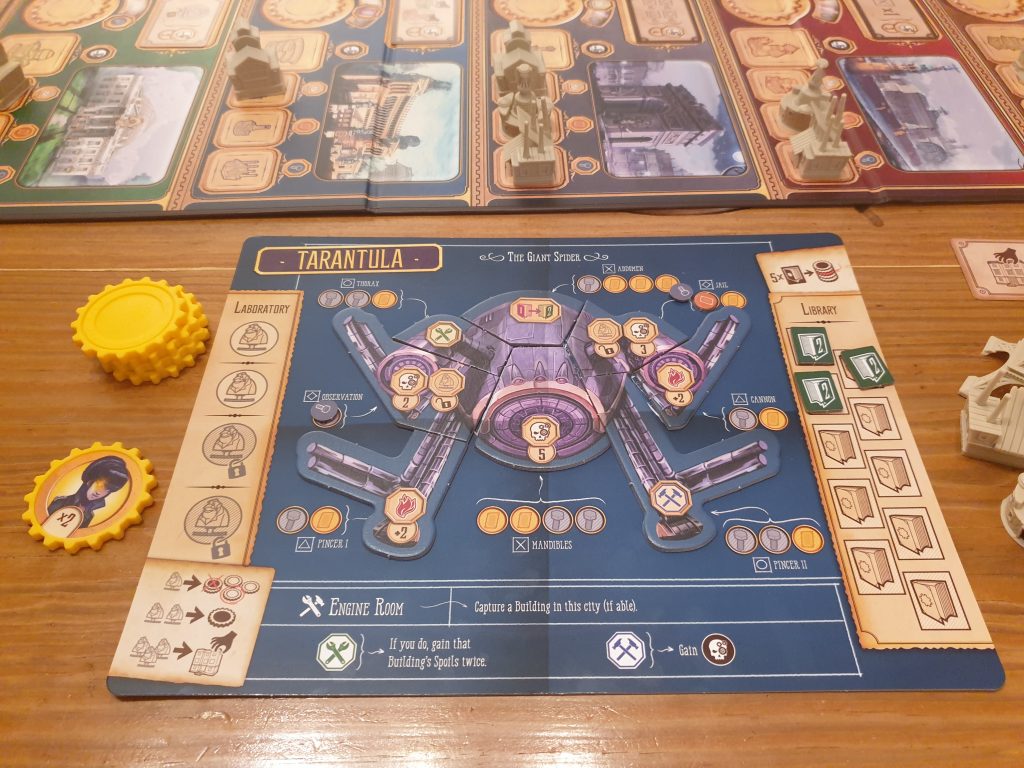Victorian Masterminds is a worker placement board game from CMON Limited, released earlier this year. Designed by Antoine Bauza and Eric M. Lang, featuring art from Davide Tosello, the game sees 2 – 4 evil masterminds wreaking havoc now that Sherlock Holmes is out of the picture. Lasting around an hour players will capture iconic buildings from around the world, build unique machines, complete dastedly missions and more. However, is it fun to be an evil mastermind? Let’s find out!
At the start of the game each player takes a unique machine player board, along with the associated 8 machine pieces. Choosing a colour players place a token on the firepower track, on the slot labelled with the correct player count, and get a coloured set of five worker tokens. The worker tokens are made into a shuffled stack and placed facedown next to the player’s board. The 5 basic mission cards are shuffled, with one player at each city location – with advanced missions to replace them put within reach. The 20 buildings are placed into slots on the main board, with piles of tokens made within reach of all players. Finally, each player claims a single scientist, before the player with the most evil laugh starts the game.
On a turn a player will draw the top worker token from their stack, checking the ability, before placing it at one of the 5 city locations. Worker tokens are placed on top of other worker tokens already at the location. If a stack is 3 workers high then it is flipped over and resolved, otherwise play continues to the next player. When resolved worker tokens at the different locations give spoils. The cities are: London, which gives copper; Washington, which gives bolts; Paris, which gives scientists; Moscow, which gives firepower and Rome, which gives Da Vinci books.
The agents a player sends to a location doesn’t change the type of spoil of a city, but offers an extra ability. The five agent tokens have different abilities: the Henchman attempts to complete the mission card on the city; the Engineer, activates your machine power (with each machine coming with a unique player power); the Saboteur negates the ability of an opponent’s disk directly below it; the Gunner attempts to claim a building from the city and last but not least, Number 2 takes double the city spoils.
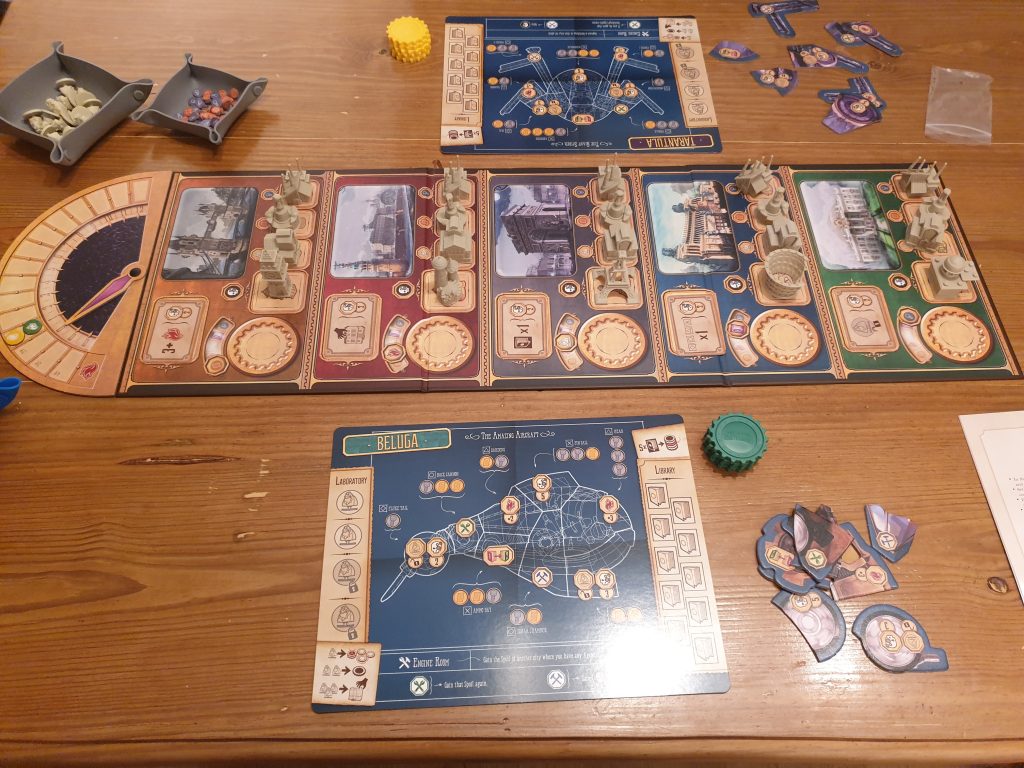
For claiming buildings and mission cards requirements need to be met by the player. For buildings the player must have a firepower rating equal to or the secret service – with every claimed building bumping the secret service’s rating up one space. Mission cards range from completing different sections of machines to owning specifically shaped buildings – like the unique St Basil’s Cathedral or the Eiffel Tower to standard universities.
Gaining copper and bolts is going to players to upgrade their machine: gaining points, firepower, additional scientist slots or bonus machine powers. It can even turn gaining a Da Vinci book from earning 1 point into 2. Da Vinci books aren’t just for end game scoring though. Having 5 books allows players to choose from their stack their agents rather than randomly shuffling and drawing the top one from the stack.
Scientists are also super useful for getting agents onto the board. Once an agent is played it stays on the board until the stack it is part of reaches 3, and then stays face up and used until all 5 agents have been used. Spending 1 scientist allows players to play a previously used face up agent, instead of the next agent form their stack. Spending 2 allows players an additional token placement and 3 sees the player claim any building from the board – regardless of the secret service level.
This might all sound like a lot and when it is first laid out on the table it can look it too. Thankfully, within a few rounds players will see how everything overlaps. With many ways to score mayhem (victory) points, the game has two game ending conditions: either a player will complete their machine or the secret service will reach full strength. At this point the game instantly ends, though working down the locations each worker stack – regardless of token count – is resolved. Players then gain points from mayhem tokens, missions completed, buildings captured, machine parts and Da Vinci books. Whomever has the most points is then proclaimed to be the best mastermind!
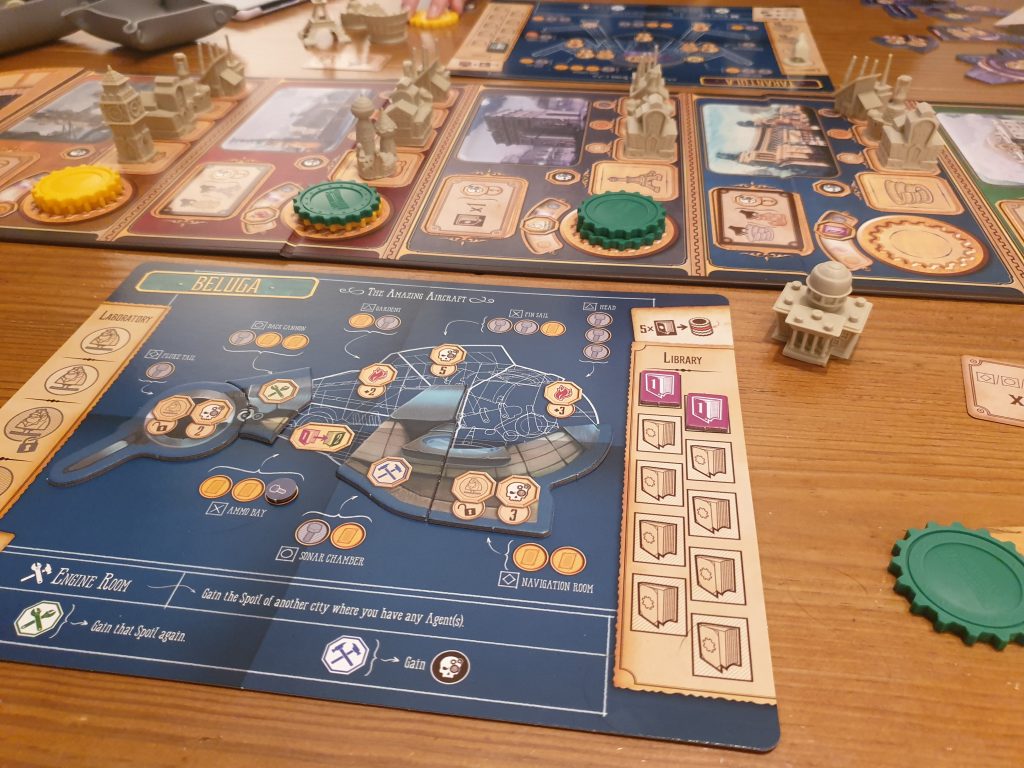
Victorian Masterminds offers something different in the way the worker placement plays out, with stacks only activating when they reach a count of 3. This creates a fun interaction between players, not wanting to help another player by completing a stack. At the same time seeing an opponent resolve an entire stack by themselves is painful. Painful, not from a bad gameplay point of view, that you let them get such an awesome payout of actions with nothing in return.
It is impossible to deny that part of Victorian Masterminds’ allure is from the plastic portion of the components. With plastic miniature buildings and scientists, the game has a wow appeal – before players look at the artwork that adorns the central and player boards. These components could easily be cardboard tokens reducing the price of the game but that isn’t how CMON produces games. Offering the game board and pieces height from the table, when gaining these pieces they feel more important due to being more than a chit.
The worker tokens are gear like poker chips, which are great to hold and place into stacks. Alas it is a shame they are a little awkward to shuffle. Awkwards being a problem with the cardboard chits for bolts and copper. They are on the fiddly side, even for small resource tokens, and alongside the machine components and scientist miniatures are sorely lacking in love from the production department.
It would have been nice to see a larger variety of mission cards included, to add some more variety between games. For a touch of additional theme these mission cards could have come with names or something as they are a bit plain. Instead of a variety of cards, to add an element of replayability the unique machines do go some way to make games feel different – though what opponents can do rarely impacts what you want to do on a turn.
There are issues with the rulebook on two fronts. Firstly, a small glossy slip is included in the box to explain rule edits – not just clarifications. This shows that the game was well into the print run before this was picked up on. Hopefully in a second print run it would be fixed. One change massively impacts how the game plays with two players. The first time at 2 players this was completely missed, with 2 player alterations not even remotely mentioned in the rulebook. Only this slip says to activate stack when there are two not three worker tokens.
To make matters worse the rulebook even with an extra slip fails to explain how a lot of the iconography works – leaving players to assume. While it seems mostly intuitive all that would be needed is a table, which at maximum would be a single side of A4, to show the symbols and list what they specifically mean. It just leaves a bad taste when a game leaves the players themselves to assume how things work, the game should spell it out for them.
The central mechanic of the stacks of workers is an enjoyable one, though it is tainted by the randomised drawing of worker tokens. Giving players a choice of the 5 worker abilities may add length to the game. Still, it would eliminate the annoyances of being pipped to a mission card solely due to an opponent drawing their henchman first. When you’ve finally unlocked this ability via Da Vinci books it opens the game up. Though it only shows how much better the experience would be if you could choose from the beginning, even bluffing the use of your ability blocking saboteur.
Overall, the core concept works but it is being let down by a few issues. The game is on the quick side for a worker placement game, so some will be fine with the elements of luck being included. Glaring oversights and missed content in the rulebook however make the game slug to a halt at times as you scan the entire booklet attempting to find something that isn’t there. For all the glorious components there are also a few that let it down, making Victorian Masterminds across the board a mixed bag, not a mastermind’s invention.
[Editor’s Note: Victorian Masterminds was provided to us by Asmodee for review purposes. The game is currently available from local UK board game stores. Find your local store here]

